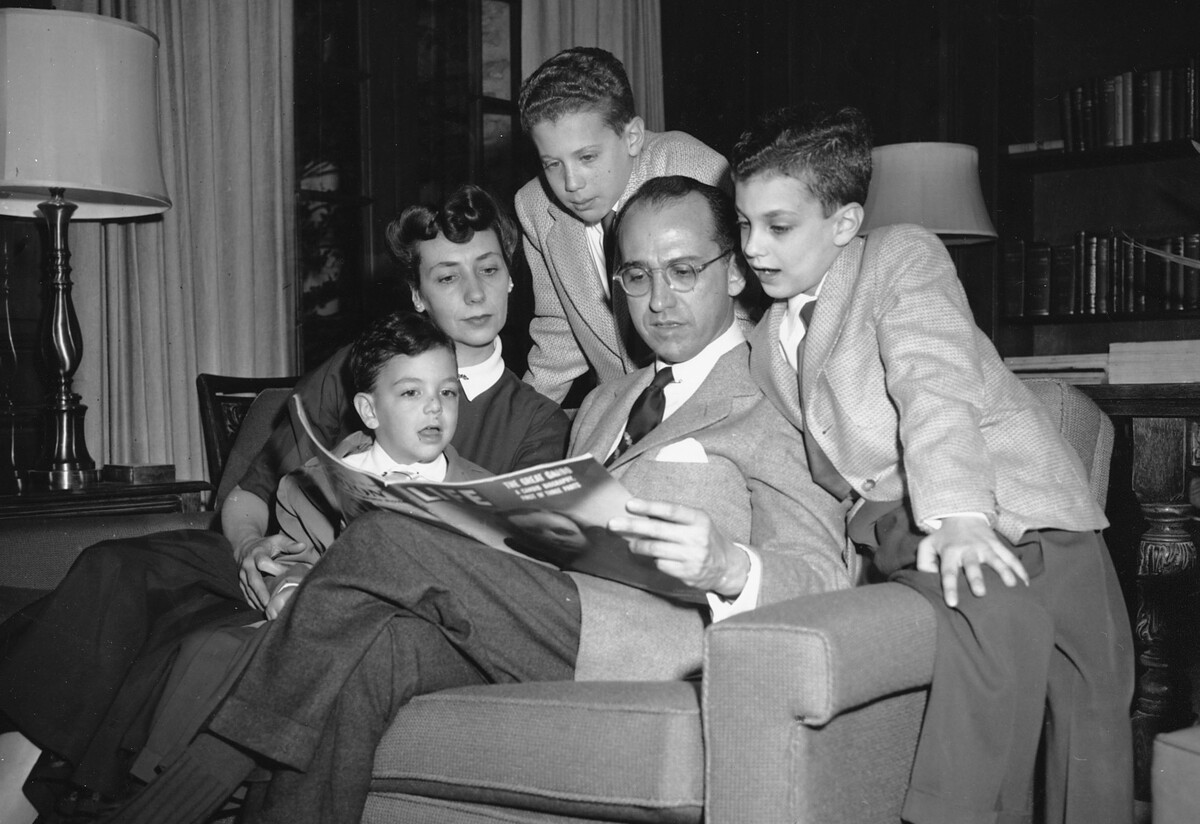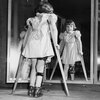
Dr. Jonas E. Salk, who discovered the polio vaccine, reads with his wife and three boys in Ann Arbor, Mich., on April 11, 1955. The boys were among the first vaccinated during testing. The family was photographed the night before an announcement the vaccine was effective. Pictured from left are Jonathan, 5; Donna Salk; Peter, 11; Salk; and Darrell, 8.
AP
hide caption
toggle caption
AP

Dr. Jonas E. Salk, who discovered the polio vaccine, reads with his wife and three boys in Ann Arbor, Mich., on April 11, 1955. The boys were among the first vaccinated during testing. The family was photographed the night before an announcement the vaccine was effective. Pictured from left are Jonathan, 5; Donna Salk; Peter, 11; Salk; and Darrell, 8.
AP
Editor’s Note: As this year winds down, we’re looking back at some people we spoke to earlier in 2020, when the coronavirus pandemic was in its early stages. Now that there’s a vaccine, we wanted to check in with someone whose family has a long history with vaccines.
When I spoke to Dr. Peter Salk back in May, he told me the tale of receiving an early polio vaccine – the one invented by his father, Dr. Jonas Salk.
“I just hated injections. And my father came home with polio vaccine and some syringes and needles that he sterilized on the kitchen stove by boiling in water, lined us kids up and then administered the vaccine,” Salk said. “Somehow the needle must have missed a nerve, and I didn’t feel it. And so that has fixed that moment in my mind.”

Peter Salk was just 9 when he got that shot in 1953 at the family home outside Pittsburgh.
At that time, polio terrorized the country every summer. In the worst single year, 1952, nearly 60,000 children were infected. Many were paralyzed, and more than 3,000 died. Frightened parents kept their children away from swimming pools, movie theaters and other public places.
The vaccine helped eradicate polio, made his father world famous, and shaped Peter Salk’s own life — he also became a doctor of infectious diseases.
Yet when we talked last spring, Peter Salk was worried about the race for a COVID-19 vaccine. He feared corners might be cut. He noted that his father, who died in 1995, needed seven years to develop a vaccine that was both effective and safe.

“What concerns me is knowing that, in the past, there have been unexpected things that have taken place with vaccines that had not been foreseen,” Salk said at the time.
Back in the 1950s, one bad batch of the polio vaccine was blamed for 10 deaths, 200 cases of paralysis and for making many Americans wary of getting the shot.
But in a recent phone chat with Salk at his home in La Jolla, Calif., just outside San Diego, he was very upbeat about the COVID vaccine.

Bill Gates speaks in 2011 in New York with descendants of key figures in the fight against polio — Peter Salk, left, and Cathy Hively, granddaughter of Basil O’Connor, who helped to battle the disease through the March of Dimes.
Seth Wenig/AP
hide caption
toggle caption
Seth Wenig/AP

Bill Gates speaks in 2011 in New York with descendants of key figures in the fight against polio — Peter Salk, left, and Cathy Hively, granddaughter of Basil O’Connor, who helped to battle the disease through the March of Dimes.
Seth Wenig/AP
“I was bowled over when the first news came out about the Pfizer, BioNTech results and being somewhere on the order of 95 percent effective,” he said. “I just had a really strong emotional reaction that I totally had not anticipated.”
He’s following the vaccine news closely and has been hugely impressed by the development of a vaccine in less than a year. There could still be hiccups, he said, but none that can’t be solved.
“In my mind, so far, so good,” he said.

Dr. Salk is a bit concerned about the number of people who are reluctant, or outright opposed, to getting the vaccine. But he believes those numbers will shrink as people see the benefits. And, he said, this “vaccine hesitancy” is nothing new.
“I was surprised when I first learned a few months ago about a Gallup poll in 1954 that indicated that about half the population did not want the polio vaccine,” he said.
That was the year before the U.S. government authorized nationwide use. In the end, most everyone received it.
The current pandemic has sharply curtailed Salk’s movements. He’s still a part-time professor of infectious diseases at the University of Pittsburgh, and has stopped traveling there.

He spends most of his time at home and says his aching knees, as well as the threat of the virus, keep him from getting out much in the neighborhood.
“My wife [Ellen] and I have been extremely careful during this whole period,” he said. “I’m probably going to continue to do social distancing and wear masks and take the precautions that I’ve been taking really until this thing is practically gone.”
Dr. Salk was at the front of the line when he got the polio vaccine as a kid. And he’s eager to get the new vaccine. But at age 76, and in good health overall, he said he’s content to wait his turn.
“We’re going to be somewhere down the line” when it comes to the vaccine, he said. “As far as I’m concerned, that’s fine with me. I think it’s really important to prioritize the limited supply of vaccine.”
As a nation, he predicts it could take until the end of 2021 before life returns to normal for the country as a whole. Until then, he’ll be playing it safe.
“I’m not ready to throw away the mask,” he said.
Follow Greg Myre @gregmyre1.
